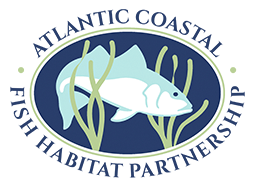ACFHP Study Finds Benthic Habitats Play an Important Role in Contributing to the Health of Coastal Fish and Invertebrates
According to the findings in the Atlantic Coastal Fish Habitat Partnership’s (ACFHP) recent article in the journal BioScience, benthic habitats play a critical role in the life cycles of most coastal fishes and invertebrates along the Atlantic coast of the United States. The article, titled ‘The Importance of Benthic Habitats for Coastal Fisheries’ presents the findings of the ACFHP Species-Habitat Matrix, which evaluates the relative importance of coastal, estuarine, and freshwater habitat types as living space during the major life stages of over 100 fish species. The study evaluated the importance of benthic habitats as a space for shelter, feeding, and breeding by coastal fishes and invertebrates in four biogeographic regions of the eastern United States: the North Atlantic (Canadian border to Cape Cod), the Mid-Atlantic (Cape Cod to Cape Hatteras), the South Atlantic (Cape Hatteras to Cape Canaveral), and South Florida (Cape Canaveral to Florida Keys).
Key findings and recommendations include:
- The importance of different habitats changed with latitude: soft sediments and riverine systems scored higher in northern regions (North and Mid-Atlantic), and marshes and coral reefs scored higher in the south (South Atlantic and South Florida).
- The ecological importance of soft sediments to fish and invertebrates have been widely undervalued. Increased recognition of the importance of this habitat in environmental assessments is essential because these areas, found in both estuarine and marine waters, are typically used for offshore energy and other development activities.
- Submerged aquatic vegetation was a key nursery habitat coast-wide.
- Anthropogenic impacts have altered habitat availability and use, and climate change is causing disturbance.
- When assessing the value of habitats in a particular site, distinct habitats (e.g., submerged aquatic vegetation) should be evaluated and managed as an interconnected ecosystem rather than in isolation.
These results can be used to evaluate trade-offs and develop habitat-management strategies. ACFHP is currently working to create a web-based tool that will allow fishery and habitat managers, scientists, and grassroots organizations to query data in the Species-Habitat Matrix to help determine the impacts of proposed coastal development or habitat restoration activities. The web-based tool should be available in the upcoming months.
The Species-Habitat Matrix was based on the expertise of many scientists along the Atlantic coast, and was spearheaded by a team of authors: Jake Kritzer (Environmental Defense Fund), Mari-Beth DeLucia (The Nature Conservancy), Emily Greene (Earth Resources Technology, Inc.), Caroly Shumway (Merrimack River Watershed Council), Marek Topolski (Maryland Department of Natural Resources), Jessie Thomas-Blate (American Rivers), Lou Chiarella (National Marine Fisheries Service), Kay Davy (National Marine Fisheries Service), and Kent Smith (Florida Fish and Wildlife Conservation Commission).
Access to the abstract and instructions to download the full article can be found here: http://bioscience.oxfordjournals.org/content/early/2016/03/04/biosci.biw014.abstract.
For more information, please contact Lisa Havel, ACFHP Coordinator, at [email protected], 703-842-0740.
